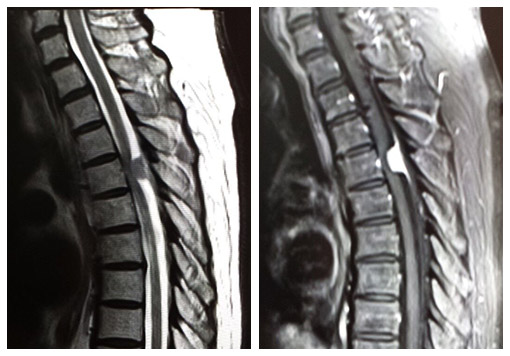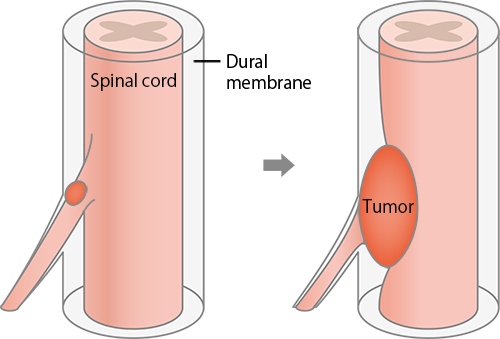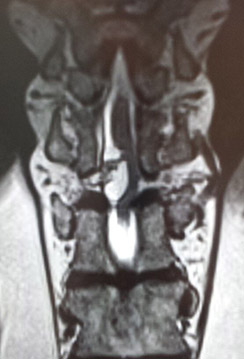- HOME
- For Patients
- Spinal cord tumors
Spinal cord tumors
- About spinal cord tumors
- Symptom of spinal cord tumors
- Diagnosis of spinal cord tumors
- Treatment of spinal cord tumors
Diagnosis of spinal cord tumors
Although an expert can diagnose patients with spinal cord tumors relatively easily, if not seen by an expert, they may remain undiagnosed until their symptoms develop significantly. If a spinal cord tumor is suspected, an MRI scan is recommended for an early diagnosis.
Extramedullary tumors
Tumors that arise outside the spinal cord matrix enlarge gradually and produce symptoms by compressing the spinal cord. Most of these tumors are benign and can be cured by surgical removal. The two most frequently seen tumor types are meningioma and neurilemmoma (Schwannoma).
(a) Meningioma
This is the most common type of extramedullary tumors. Meningiomas arise from the inner surface of the dura mater, a hard membrane that contains the spinal cord. The MRI scans below show how it compresses the spinal cord from the dorsal side, causing symptoms.

(b) Neurilemmoma (Schwannoma)
This is the second most common type of extramedullary tumors. Neurilemmomas, also known as Schwannomas, arise from cells forming the sheaths of the nerves originating from the spinal cord. As they grow larger, they too produce symptoms by compressing the spinal cord. Most cases first present with pain in the distribution of the compressed nerve.


Intramedullary tumors
Intramedullary tumors grow out of the spinal cord itself, and they too cause progressive symptoms as they gradually enlarge. The main types are astrocytoma, ependymoma, and angioblastoma.
(a) Astrocytoma
Like gliomas, which are found in the brain, astrocytomas arise from a type of cell known as stellate cells. They are comparatively common in children. Their nature may range from benign to extremely malignant.
(b) Ependymoma
Like astrocytomas, ependymomas are also a type of glioma. They arise from cells called ependymocytes, and they tend to be more common in adults. They too may be either benign or malignant, but compared with astrocytomas, they are more likely to be benign and can be cured by careful surgery.
(c) Angioblastoma
Angioblastomas are benign tumors containing numerous blood vessels that occur in both the brain and spinal cord. They can be cured by surgical removal, but those in the spinal cord require far more delicate surgery to remove than those in the brain, and both skill and experience are needed for the procedure.
Doctor's Info Han Soo Chang







